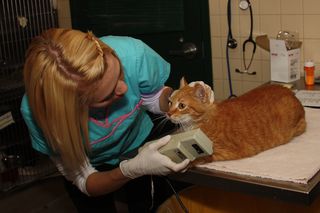A rapid DNA test lets animal shelters know with certainty that a cat or kitten is negative for ringworm, allowing those kitties to head straight out to the adoption floor or into foster care without concern that they might be contagious.
The test considered the “gold standard” for diagnosing ringworm (Microsporum canis dermatophytosis) in cats is the fungal culture. A sample of the cat’s fur is taken, and then a laboratory tries to grow the fungus that causes ringworm from that sample. Unfortunately for cats suspected of being infected, this process can take 2-3 weeks to obtain results. This means that cats who aren’t actually infected will be held for weeks of treatment when they could have been safely adopted or fostered.
There is, however, a faster test. In a study published in the Journal of Feline Medicine and Surgery, researchers compared the reliability and speed of the fungal culture with a type of DNA test known as a real-time PCR, which stands for “polymerase chain reaction.” Results from this test are available in 1-3 days.
The study looked at 132 shelter cats, and found that the faster PCR test didn’t miss any positive cats. That means it was 100 percent reliable in identifying cats who had ringworm, which in turn means that any cat it said was negative truly was negative, and was safe to go out into the community.
The test wasn’t as accurate in its identification of positive cats, however. It wrongly identified a few cats (12/104) as having ringworm when the culture indicated they actually didn’t. These false-positive results suggested to the study authors that the PCR test may have been sensitive enough to detect all of the following:
- True disease
- Contamination from surfaces (fomites)
- Non-viable fungal spores (which can’t cause disease but can be detected in a DNA test)
In shelters that treat for ringworm, this simply means that a small number of cats will be treated for ringworm even though they don’t have it. The real risk is in those shelters that don’t treat the condition. As the study authors cautioned, “For shelters that euthanize cats with confirmed dermatophytosis, fungal culture has the advantage of a lower potential for false-positive results.”
Also important to note is that neither the PCR test nor the fungal culture can tell the difference between a true infection and exposure that will quickly clear on its own. For that reason, the examining veterinarian’s clinical evaluation, as well as examination with a Wood’s lamp (which “lights up” fungus on the fur) and microscopic examination of the cat’s hairs, all need to be utilized along with either of the laboratory tests.
Finally, while the speed of the PCR test is a clear advantage over the fungal culture for diagnosis, it didn’t perform as well when looking at whether or not a cat was cured after treatment. For that reason, the authors recommended that fungal culture continue to be used during and after treatment.
Linda S Jacobson, Lauren McIntyre, Jenny Mykusz. Comparison of real-time PCR with fungal culture for the diagnosis of Microsporum canis dermatophytosis in shelter cats: a field study. Journal of Feline Medicine and Surgery, Vol 20, Issue 2, pp. 103 – 107. March 7, 2017. https://doi.org/10.1177/1098612X17695899

